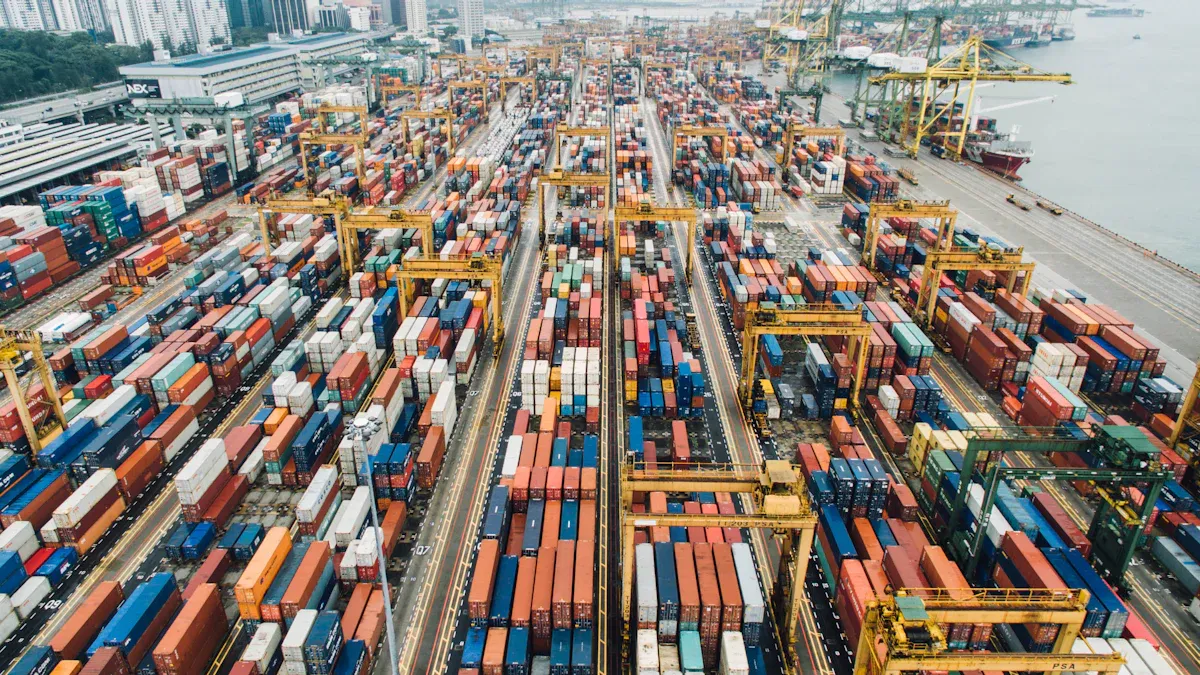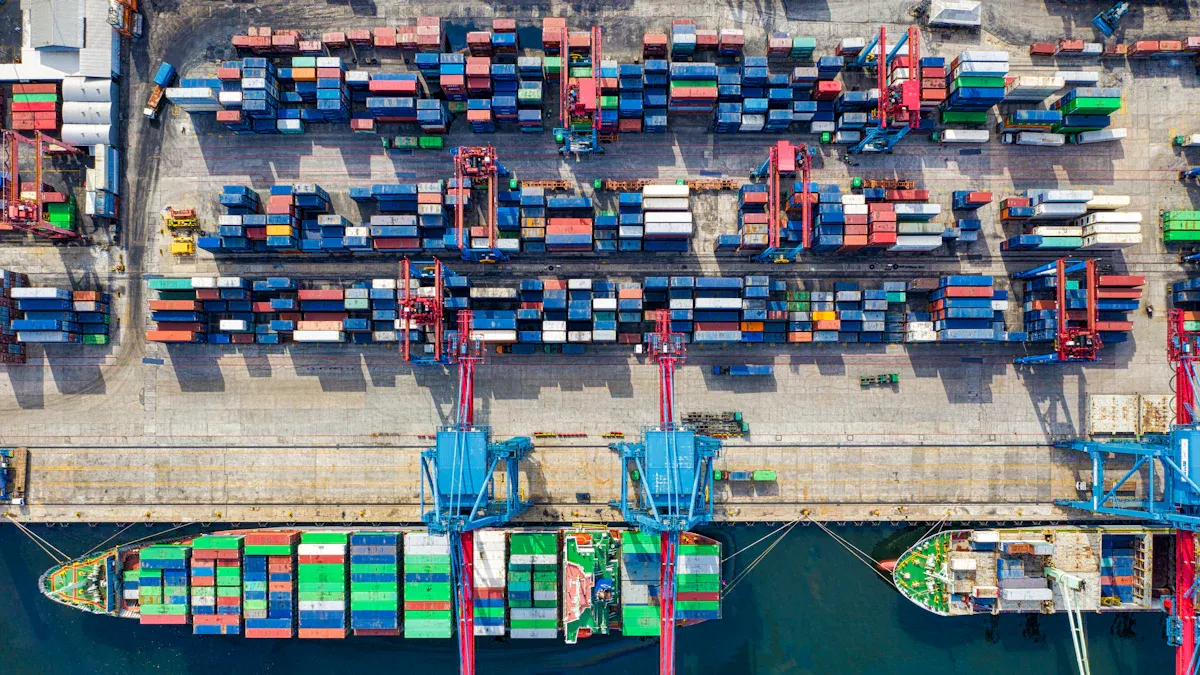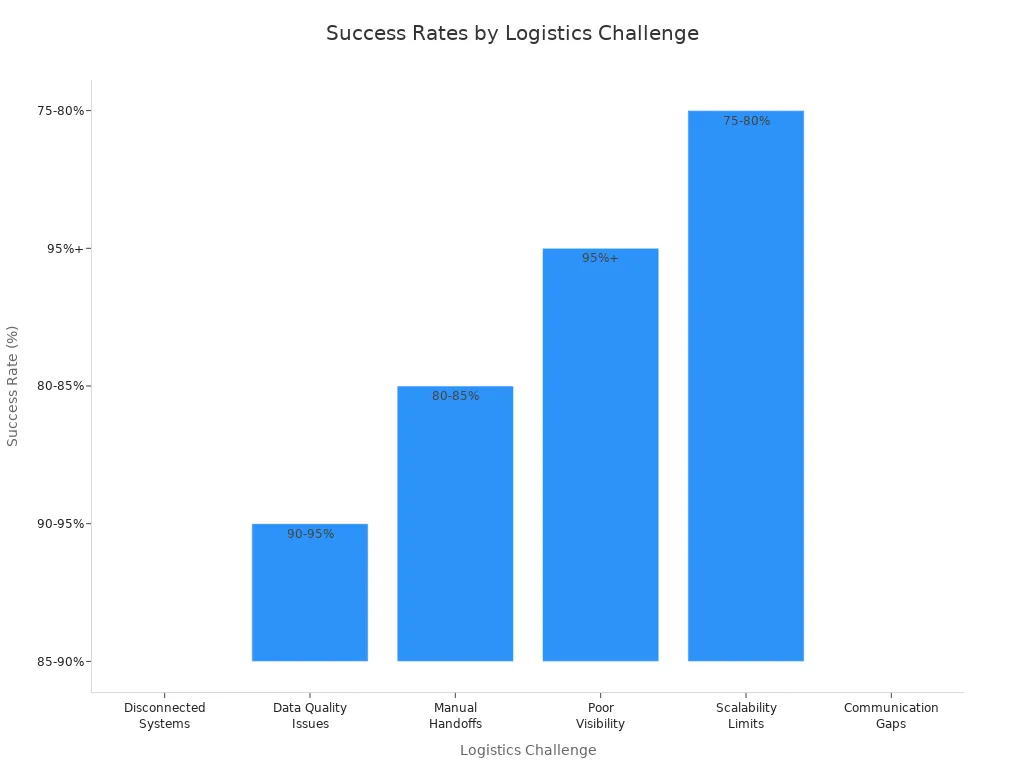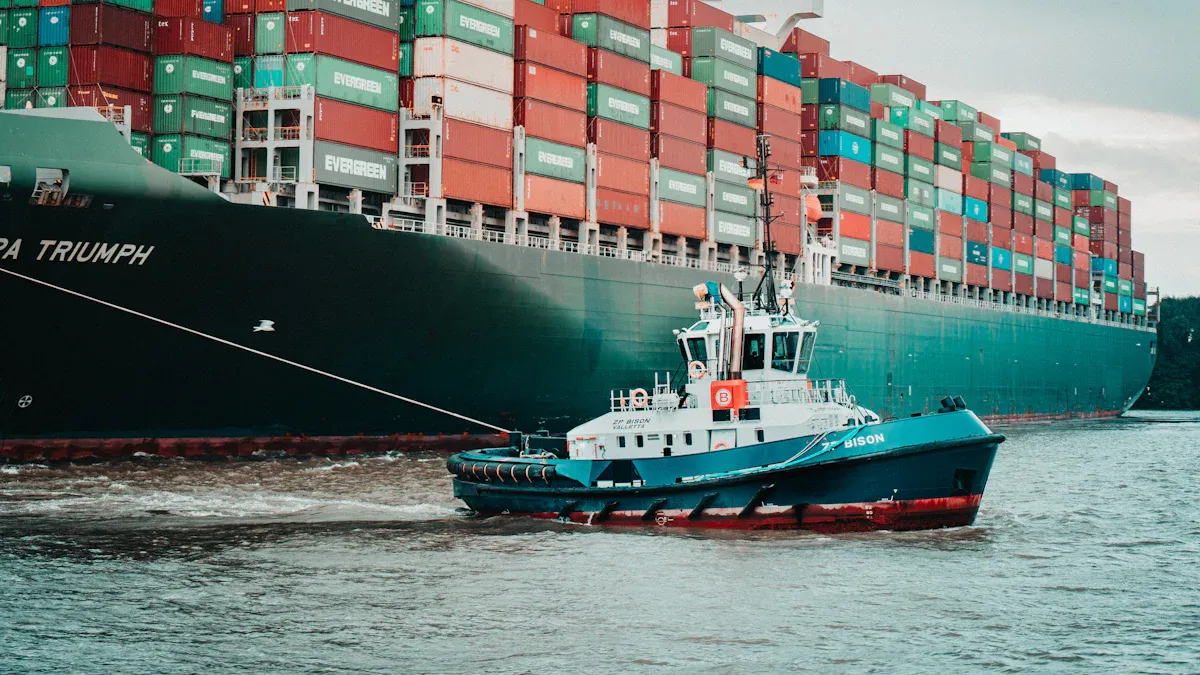What Does Full-Service Management Mean in Premier Global Logistics

Full-service management in global logistics means you trust one provider to handle every step of your supply chain. This approach gives you complete support, from order processing to final delivery. You gain clear visibility, better planning, and more time to focus on your core business.
Recent industry reports show that end-to-end logistics support offers:
Improved forecasting and planning through full supply chain visibility
More freedom to focus on your main strengths by outsourcing logistics
As companies face labor shortages, many automate warehouse tasks and integrate systems for better efficiency. These trends make premier global logistics full-service management a smart choice for businesses that want to grow quickly. The market for this service is expected to grow at a CAGR of 7.2% from 2024 to 2030.
Key Takeaways
Full-service management simplifies your logistics by providing one provider for all supply chain needs. This reduces confusion and saves time.
You gain better control and efficiency through integrated systems that streamline order processing, warehousing, and transportation.
Using advanced technology, full-service management offers real-time tracking and data insights, helping you make informed decisions.
Outsourcing logistics allows you to focus on your core business, leading to faster deliveries and improved customer satisfaction.
Choosing a full-service provider can lead to significant cost savings, with many companies reporting reductions of 10 to 20 percent in logistics expenses.
Definition
Meaning
When you choose full-service management in global logistics, you let one provider handle every part of your supply chain. This means you do not need to work with many different companies. Instead, you get a single team that plans, manages, and supports all your logistics needs. You can count on them for planning and maintenance, as well as logistics support and support staff. This approach helps you save time and avoid confusion.
You get help with every step, including:
Planning and maintenance
Logistics support and support staff
You do not have to worry about missing details or delays. Everything works together smoothly, so your business can run better.
Key Features
Full-service management covers many important parts of logistics. You can see how each part fits together to make your supply chain strong and reliable. Here are some of the main services you get:
Warehousing & Storage
Packaging
Transportation and Trucking
Information Logistics
These services work together to give you a complete solution. You can also expect advanced features that make your logistics even better. The table below shows some of the most common features you will find in a full-service solution:
Feature | Description |
|---|---|
Inventory Management | Advanced tracking and automated inventory control to maintain optimal stock levels. |
Warehouse Management | Automation of warehouse operations, including order picking and storage optimization. |
Transportation Management | Strategic planning and route optimization for efficient delivery. |
Real-Time Tracking | Provides updates and visibility into logistics operations. |
Analytics and Reporting | Data-driven insights for continuous improvement and informed decision-making. |
Scalability and Integration | Compatibility with existing systems and the ability to grow with your business needs. |
You also benefit from:
Warehouse management that gives you visibility inside the warehouse for better inventory control.
Order management that automates order fulfillment.
Transportation management for first-mile and last-mile deliveries.
Fleet management to use your vehicles more efficiently.
Route planning and optimization to make sure deliveries arrive on time.
Invoicing that happens automatically for each delivery.
Integration marketplace that connects with your other business systems.
Tip: When you use premier global logistics full-service management, you get all these features in one place. This makes your supply chain easier to manage and helps your business grow.
Core Services

Premier global logistics full-service management brings all your logistics needs together under one provider. You get a single team that handles every step, from order processing to packaging. This approach helps you avoid confusion and delays. You gain better control, faster response times, and improved efficiency across your supply chain.
Order Processing
You can trust your provider to manage orders from start to finish. Integrated order processing reduces errors and speeds up delivery. When systems connect, you see fewer mistakes and faster cycle times. The table below shows how integration solves common order challenges:
Challenge | Impact | Solution | ROI Timeline | Success Rate |
|---|---|---|---|---|
Disconnected Systems | More errors, longer cycle times | API integration, middleware | 6-12 months | 85-90% |
Data Quality Issues | Order delays, more service calls | Data management, validation rules | 3-6 months | 90-95% |
Manual Handoffs | Higher labor costs, delays | Workflow automation | 4-8 months | 80-85% |
Poor Visibility | Complaints, inventory issues | Real-time dashboards | 2-4 months | 95%+ |
Scalability Limits | System crashes at peak times | Cloud migration | 6-18 months | 75-80% |
Communication Gaps | More exceptions | Automated notifications | 3-6 months | 85-90% |

Warehousing
Advanced warehousing technology helps you keep track of your products. Automation, like barcode scanning and robotic arms, makes picking and packing faster and more accurate. You avoid overstocking and stockouts, so customers get their orders on time. Automated systems run day and night, which means your business never stops.
Uses robots and conveyor belts for fast movement
Monitors stock levels in real time
Improves delivery times and customer satisfaction
Inventory
With premier global logistics full-service management, you get smart inventory strategies. Your provider uses demand forecasting and inventory planning to keep the right products in stock. You avoid running out or having too much inventory. Regular tracking and analysis help you make better decisions.
Demand forecasting based on real data
Inventory planning for sales and seasons
Timely ordering and replenishment
Performance monitoring to improve processes
Transportation
Transportation solutions in full-service management focus on speed and reliability. You get real-time updates and optimized routes. This means your shipments arrive faster and with fewer problems. The table below compares full-service management to traditional models:
Feature | Full-Service Management | Traditional Logistics Models |
|---|---|---|
Speed | May lack integration and responsiveness | |
Reliability | Real-time data improves reliability | Less responsive to changes |
Operational Efficiency | Optimized processes for higher efficiency | Manual processes slow things down |
Advanced technology for better efficiency
Real-time tracking for improved reliability
Material Handling
Material handling becomes safer and more efficient with automation. Robots and automated vehicles move goods quickly and reduce the risk of injury. You see fewer mistakes and faster movement of products through your warehouse.
Automated guided vehicles (AGVs) follow set paths
Robotic arms handle picking and packing
Continuous operations with less downtime
Packaging
Packaging optimization saves you money and helps the environment. Your provider uses standardized box sizes and eco-friendly materials. Smart packaging technology, like RFID tags, lets you track goods and reduce waste.
Strategy | Impact on Costs | Environmental Impact |
|---|---|---|
Standardized Packaging | Reduces shipping costs | Minimizes waste |
Sustainable Materials | Lowers disposal costs | Reduces ecological footprint |
Smart Packaging Technologies | Cuts operational costs | Improves tracking, reduces losses and waste |
Tip: When you choose premier global logistics full-service management, you get all these services working together. This integration streamlines your supply chain, reduces costs, and helps your business grow.
Premier Global Logistics Full-Service Management
Integration of 3PL and 4PL
You get the best of both worlds when you choose a provider that combines 3PL and 4PL services. A 3PL, or third-party logistics provider, handles the daily movement of your goods. They manage tasks like shipping, warehousing, and order fulfillment. A 4PL, or fourth-party logistics provider, takes a bigger role. They design and manage your entire supply chain, making sure every part works together for your business goals.
Here is a quick look at how 3PL and 4PL compare:
Aspect | 3PL | 4PL |
|---|---|---|
Core Focus | Day-to-day logistics operations | Optimizing the entire supply chain |
Vendor Relationship | Transactional, focused on costs | Long-term strategic partnership |
Asset Ownership | Owns trucks and warehouses | Non-asset based, focuses on management |
Cost Management | Reduces logistics costs | Improves overall performance and cost |
You benefit from this integration because you get both tactical support and strategic planning. A 3PL focuses on moving your products, while a 4PL builds a plan for your whole supply chain. You see better results because your provider manages every detail, from shipping to strategy.
3PLs handle the physical movement of goods.
4PLs manage the entire fulfillment process, including working with 3PLs.
Communication with 3PLs is about their services, but 4PLs connect all supply chain activities.
Premier global logistics full-service management brings these services together. You get a single partner who can move your goods and also help you plan for growth.
End-to-End Oversight
You need to see and control every part of your supply chain. Premier global logistics full-service management gives you this power. Your provider connects all systems and teams, so you always know what is happening. This approach helps you spot problems early and fix them fast.
Here are some ways providers give you full oversight:
Strategy/Technology | Description |
|---|---|
System-to-System Integration | Connects all logistics operations for better oversight |
Exception Management Protocols | Detects disruptions early and solves problems quickly |
Executive Dashboards | Shows key performance indicators and business results |
Centralized Logistics Management | Makes communication and oversight simple |
Customization and Dynamic Solutions | Adapts logistics to your business needs for more agility and resilience |
You also get:
End-to-end visibility and control tower management
Real-time logistics execution
Inventory optimization
Connection of suppliers, 3PL providers, and digital systems
With this level of oversight, you can make better decisions. You see where your products are, how your supply chain is working, and what needs to change. You stay ahead of problems and keep your customers happy.
Note: Companies like XPO use their experience and network to offer dynamic solutions. Their control tower centralizes management, making it easier for you to oversee your supply chain.
Technology Use
Technology drives premier global logistics full-service management. You get advanced tools that make your supply chain faster, smarter, and more reliable. Providers use global enterprise freight management systems to keep everything running smoothly. Web-based transportation solutions give you real-time updates, so you always know where your shipments are.
You also benefit from Electronic Data Interchange (EDI). This system lets your business and your provider share information quickly and accurately. You avoid delays and mistakes because everyone works from the same data.
Some key technologies include:
Global enterprise freight management systems for efficient operations
Web-based transportation solutions for better visibility
EDI for fast and accurate communication
These tools help you track shipments, manage inventory, and plan routes. You save time and money because technology makes every step more efficient.
Tip: When you use premier global logistics full-service management, you get the latest technology and expert support. This combination helps your business grow and keeps your supply chain strong.
Business Benefits

Efficiency
You want your supply chain to run smoothly. Full-service logistics management helps you reach this goal. Your provider uses advanced systems to cut down on wasted time and speed up every process. You see faster order processing and fewer mistakes.
Non-value-added time in warehouse processes drops to about 30%.
Process cycle efficiency rises to nearly 70%.
Lead time for processing orders falls to just over 131,000 seconds.
These improvements mean you get products to your customers faster. Your team spends less time fixing errors and more time growing your business.
Cost Savings
You can save money by switching to full-service logistics management. Your provider looks at your entire supply chain to find ways to cut costs. They use data to spot expensive steps and remove waste.
You learn your current logistics costs and compare them to industry averages.
You find the biggest cost drivers, such as transportation, inventory, and labor.
Data-driven strategies help you cut unnecessary expenses.
Many companies save 10 to 20 percent each year and improve delivery performance.
Tip: Lower costs mean you can invest more in other parts of your business.
Risk Reduction
You face many risks in logistics, such as delays, lost goods, or supply chain disruptions. Full-service management uses proven strategies to lower these risks. Your provider prepares for problems before they happen.
Strategy | Description |
|---|---|
Conducting Thorough Risk Assessments | Finds weak spots in your supply chain and protects them. |
Developing Contingency Plans | Sets up steps for unexpected problems to keep your business running. |
Establishing Robust Relationships | Builds strong ties with suppliers to avoid disruptions. |
Implementing Just-In-Time (JIT) Inventory | Keeps inventory low and fresh, so you do not waste money. |
Collaboration | Works with suppliers to plan for risks and share solutions. |
You gain peace of mind knowing your supply chain is ready for anything.
Scalability
Your business needs to grow and change. Full-service logistics management gives you the flexibility to scale up or down as needed. Your provider can handle more orders during busy seasons and support new shipping methods.
Your logistics partner adapts quickly to changes in order volume.
You avoid delays and stockouts, keeping your customers happy.
You can add new services, like international shipping or extra warehouses, as your business grows.
Note: Scalability means you never have to worry about outgrowing your logistics solution.
Comparison
Full-Service vs. 3PL/4PL
You may wonder how full-service management compares to 3PL and 4PL providers. Each model offers different levels of support and control. Full-service management gives you a single partner who handles every part of your supply chain. 3PL providers focus on daily logistics tasks, while 4PL providers manage the entire supply chain and coordinate with multiple partners.
Here is a table that highlights the key differences:
| Aspect --- | 3PL Provider --- | 4PL Provider --- | | Primary Role --- | Operational logistics support --- | Strategic supply chain management --- | | Scope of Services --- | Transportation, warehousing, fulfillment --- | End-to-end supply chain management --- | | Technology --- | Limited tracking systems --- | Advanced analytics and visibility tools --- | | Coordination --- | Works with a few logistics partners --- | Oversees multiple 3PLs and vendors --- | | Best Fit For --- | Companies needing specific services --- | Companies seeking full integration --- | | Risk Management --- | Operational risks --- | Operational and strategic risks --- |
Full-service management combines the strengths of both 3PL and 4PL. You get operational support and strategic oversight in one solution. This approach helps you manage risks, improve visibility, and streamline your logistics.
Tip: If you want a partner who can handle everything from shipping to strategy, full-service management is the best choice.
Specialized Services
Specialized logistics services focus on specific tasks, such as transportation or warehousing. These services offer flexibility and can be customized to meet your needs. Full-service management, on the other hand, provides highly tailored solutions for your entire supply chain.
| Service Type --- | Flexibility and Customization --- | | Logistics Management Services --- | Standardized solutions with some customization --- | | End-to-End Logistics --- | Highly customizable for unique business needs --- |
When choosing between full-service management and specialized services, consider these criteria:
| Criteria --- | Description --- | | Company Size --- | Smaller businesses may prefer simpler models. Larger firms benefit from outsourcing. --- | | Budget --- | Limited budgets suit simpler models. Larger firms can invest in complex solutions. --- | | Supply Chain Complexity --- | Complex operations need advanced models. Simple operations can use basic services. --- |
You should also look for adaptability, competitive costs, provider location, international service network, clear pricing, strong customer service, shipment tracking, accurate inventory management, and insurance coverage.
Note: Transitioning to full-service management can bring challenges, such as demand forecasting, customer service, storage costs, supplier management, and technology integration. You need to plan carefully and choose a provider who understands your business.
Full-service management in global logistics means you get one partner for every step of your supply chain. You see faster fulfillment, lower costs, and happier customers. Companies using end-to-end solutions report up to 25% faster cycles and higher satisfaction. To choose the right provider, look for real-time tracking, clear pricing, and strong support.
Consideration | Why It Matters |
|---|---|
Technology | Real-time tracking and route optimization |
Cost Structure | Transparent pricing, no hidden fees |
Customer Support | Fast help and problem-solving |
Start by mapping your needs, setting up integrations, and reviewing provider networks to ensure your business grows with confidence.
FAQ
What is full-service management in global logistics?
You get one provider to handle every part of your supply chain. This includes order processing, warehousing, transportation, and more. You do not need to manage many companies. Everything works together for better results.
How does full-service management help my business grow?
You save time and money because your provider handles all logistics tasks. You can focus on your main business. You also get faster deliveries and better customer service.
Can I track my shipments in real time?
Yes! You get real-time tracking tools. You always know where your products are. This helps you plan better and answer customer questions quickly.
What makes full-service management different from 3PL or 4PL?
You get both daily support and big-picture planning. A 3PL handles shipping and storage. A 4PL manages the whole supply chain. Full-service management combines both for a complete solution.
See Also
Experience Multi-Channel Fulfillment with Premier Global Logistics
Accelerate Your Orders with Premier Global Logistics Warehousing
Reasons to Select Premier Global Logistics for Exports
Eliminate Delays with Premier Global Logistics Efficient Warehousing
Enhancing Efficiency on the West Coast with Premier Logistics
